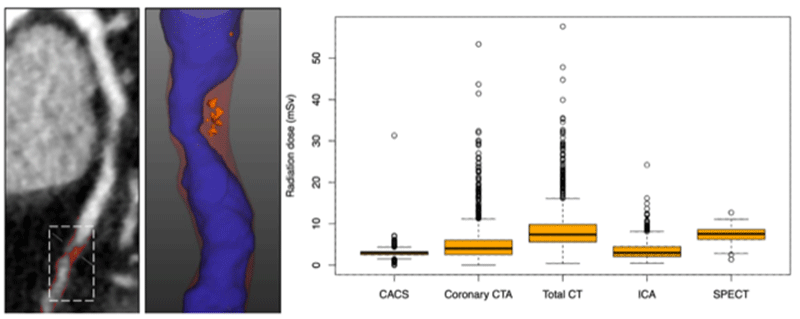Assessing Radiation Exposure in the SCOT-HEART Trial
Radiation exposure is an important concern in cardiovascular imaging because of its relation to lifetime cancer risk

An evaluation of the cumulative radiation exposure of patients who underwent CT imaging during the Scottish Computed Tomography of the Heart (SCOT-HEART) Trial suggests that coronary CT angiography (CCTA) may provide a relatively safe and practical approach to diagnosis and management of patients with stable chest pain.
“The SCOT-HEART trial is a landmark multi-center randomized controlled trial looking at the use of computed tomography to guide the management of patients with suspected angina due to coronary artery disease, which has led to changes in national and international guidelines,” said Michelle C. Williams, MBChB, PhD, a senior clinical research fellow at the University of Edinburgh in the U.K.
According to Prof. Williams, improvements in current and advancing technology, such as the use of better methods to reduce radiation dose and new analysis techniques, make heart CT scans more appealing for patients with chest pain, as they can help improve patient outcomes compared to other methods.
CCTA use also helps reduce the application of more invasive diagnostic procedures like invasive coronary angiography (ICA) leading to a reduction in health care costs and potential risks associated with these procedures. However, concerns over the effects of cumulative radiation exposure remain.
“Radiation exposure is an essential health care consideration, and it is important for cardiac imaging to consider the radiation dose of both initial and subsequent investigations,” Prof. Williams said. “The findings from the SCOT-HEART trial showed that using CCTA in addition to standard care led to more accurate and improved diagnoses of coronary artery disease. It was, therefore, the perfect place to address the question of radiation exposure.”

Cardiac CT provides information to guide management and improve outcomes but involves radiation exposure. Curved planar reformations of a coronary artery with a moderate stenosis showing non-calcified plaque in red and high- risk low attenuation plaque in orange. Box-plot showing radiation doses for the first diagnostic imaging test in the SCOT-HEART trial, including coronary artery calcium score (CACS), coronary CT angiography (CTA), combined CACS and coronary CTA, invasive coronary angiography (ICA) and single photon emission computed tomography (SPECT).
Initial CT Exam Drives Higher Cumulative Radiation Exposure
For the study, Prof. Williams and her colleagues included data from 2,894 participants with stable chest pain, recruited between November 2010 and September 2014, with follow-up through January 2018.
The participants were randomized into two groups—one with 1,428 patients receiving standard care such as clinical assessment and functional testing, and the other with 1,466 receiving standard care and CCTA.
The researchers assessed the radiation dose of several imaging modalities used during the trial including CT, single photon emission CT, and ICA for five years after enrollment. They compared the cumulative radiation dose in the CCTA group with that of the standard care group.
Listen as Prof. Williams discusses her research.
According to Prof. Williams, the five-year cumulative radiation exposure per-participant was higher in the CT group than in the standard care group. In addition, when the researchers looked at participants who underwent any imaging over the five-year period, they found that the cumulative radiation dose was still higher in the CT group than in the standard-care group.
Prof. Williams and her colleagues will continue to look at overall radiation exposure linked to cardiac CT.
“We are recruiting participants for the SCOT-HEART2 randomized controlled trial which will assess the use of coronary CT angiography in asymptomatic patients,” Prof. Williams said. “Radiation exposure is an important secondary outcome in this trial.”
For More Information
Access the Radiology study, “Evaluating Radiation Exposure in Patients with Stable Chest Pain in the SCOT-HEART Trial” and accompanying editorial, “Radiation in Cardiac CT: Unveiling the 5-year Impact on Patients with Stable Chest Pain.”
Read previous RSNA News stories about radiation exposure: